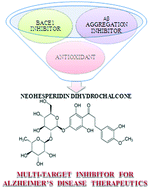Multi-functional neuroprotective activity of neohesperidin dihydrochalcone: a novel scaffold for Alzheimer's disease therapeutics identified via drug repurposing screening†
Abstract
Alzheimer's disease (AD) is a complex neurological disorder where many pathogenic signaling cascades are simultaneously activated. Moreover, their inter-relations and molecular reasons for activations are not completely understood, which impedes the development of therapeutics for AD. Multi-target drug discovery has recently come into prominence, particularly in the case of AD, due to the ability of the potential hits to simultaneously inhibit many pathways causing the disease. The present study reports the application of an FDA approved sweetener, neohesperidin dihydrochalcone (NHD), as a multi-target inhibitor for AD therapeutics. NHD shows a high BACE1 and amyloid aggregation inhibition ability as well as strong anti-oxidant activity. NHD binds to the active site of BACE1 and thus induces a conformational transition to a closed complex, which excludes substrate recognition, evident from steady-state and time-resolved fluorescence spectroscopy. 500 nM NHD completely inhibits the activity of BACE1. 8-Anilino-1-naphthalenesulfonic acid (ANS), Thioflavin-T fluorescence assay and Atomic Force Microscopy (AFM) studies confirm that co-incubation of equimolar NHD with Aβ25–35 almost completely inhibits Aβ25–35 fibril formation. Co-incubation of NHD with Aβ25–35 entirely alleviates the neurotoxic effects of equimolar Aβ25–35. NHD dose-dependently inhibits Aβ25–35 induced cellular ROS generation. In vitro bio-assays confirm that NHD is itself a strong anti-oxidant and shows scavenging activity against a wide variety of radicals. Our results clearly indicate that NHD changes the aggregation pathways of Aβ in such a way that the formations of toxic oligomeric/fibrillar forms are reduced significantly. The present study demonstrates the multi-target inhibitory potency of NHD in AD therapeutics identified via drug repurposing screening.



 Please wait while we load your content...
Please wait while we load your content...